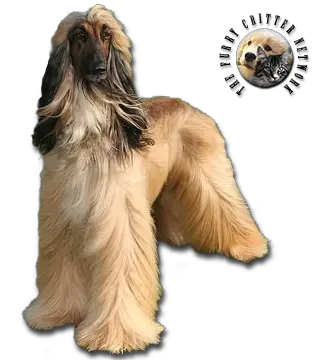Breed Standard
Head: Long. Skull long, not too narrow. Prominent occipital peak. Slight stop. Long muzzle. Powerful jaws.
Ears: Set on low, carried very flat against the head, covered with long, silky hair.
Eyes: Nearly triangular, slightly slanted, preferably dark, but a golden shade is not a fault.
Body: Long. Long, strong neck. Deep chest. Well-sprung ribs. Prominent, fairly widely spaced hip bones. Flat, muscular back sloping slightly toward the hip. Straight, strong, fairly short loin.
Tail: Not too short, forming a ring at the tip, sparsely covered with hair, carried high in action.
Hair: Very long, silky, fine hair covering the forequarters, hindquarters, and entire body except the back from the withers to the base of the tail, where the hair is short and dense. Long, silky forelock starting on the forehead. Short and dense on the foreface. Ears and legs covered with long, abundant hair.
History
The Afghan Hound's origins are practically unknown. A cousin of the Saluki (Persian Greyhound), his ancestors are thought to have been brought from Persia (Iran) to Afghanistan, where they might have developed their long coat. A favorite of Afghan royalty, Afghan Hounds were brought to England by British soldiers around 1890, after the second Afghan War. The first specimens shown in London in 1907 were a big hit. An English breed club was founded in 1926, and the breed appeared in France around 1930. Afghans were a huge fad in the 1980s.
The beauty of Afghan Hound dogs caused them to become highly desirable show dogs and pets, and they are recognised by all of the major kennel clubs in the English-speaking world. One of the Amps Ghazni, Sirdar, won BIS at Crufts in 1928 and 1930. An Afghan hound was featured on the cover of Life Magazine, November 26, 1945. Afghan Hounds were the most popular in Australia in the 1970s, and won most of the major shows. An Afghan Hound won "Best in Show" at the 1996 World Dog Show in Budapest. Afghan hounds were "Best in Show" at the Westminster Kennel Club Dog Show in 1957 and again in 1983.
Behavior
The temperament of the typical Afghan Hound can be aloof and dignified, but happy and clownish when playing. The breed has a reputation among dog trainers of having a relatively low obedience intelligence; as defined by author Stanley Coren. The Afghan has many cat-like tendencies and is not slavish in its obedience as are some other breeds. The Afghan has a leaning towards independence. Owners should not be surprised if their Afghans sometimes choose to ignore commands. Although seldom used today for hunting in Europe and America where they are popular, Afghans are frequent participants in lure coursing events and are also popular as show dogs.
Function
Although seldom used today for hunting in Europe and America, where they are popular, Afghan Hounds are frequent participants in lure coursing events and are also popular in the sport of conformation showing.
Health
Afghan Hounds in UK surveys had a median lifespan of about 12 years, which is similar to other breeds of their size. In a 2004 UK Kennel Club survey, the most common causes of death were cancer (31%), old age (20%), cardiac (10.5%), and urologic (5%). Major health issues are allergies, and cancer. Sensitivity to anesthesia is an issue the Afghan Hound shares with the rest of the sighthound group, as sighthounds have relatively low levels of body fat.






